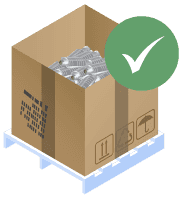Catalytic Converter Price
The Evolution of the Price List for Catalytic Converter Value

A few decades after the first catalytic converter was invented, their prices skyrocketed. The platinum, palladium, and rhodium they contain made them valuable recyclable scrap.
But how did recyclers evaluate catalytic converter prices?
We’re giving you everything you need to know about the evolution of the price list, where it stands today, and what are the best ways to evaluate your scrap converters.
Understanding what determines the value of your catalytic converter
A catalytic converter’s worth has always been tied to its precious metals content. But over the years, the industry has learned that understanding the value of your catalytic converter requires more than just knowing it contains platinum, palladium, and rhodium.
Today, recyclers consider a long list of factors, like the converter’s origin (whether OEM or aftermarket), its metal content, the serial number, and even the health of its internal honeycomb structure.
OEM converters command higher scrap value because vehicle manufacturers load more precious metals into the substrate to meet strict emissions standards.
Aftermarket units typically contain lower quantities of PGMs, which is why their scrap prices are significantly lower.
Modern price lists now clearly separate OEM and aftermarket categories, allowing buyers to quickly gauge the expected payout.
Another major influence is global metal prices. Since converter values are directly tied to the current price of PGMs, recyclers depend on accurate and real-time updates. When market price volatility is high, even one day can shift the market value of a used catalytic converter. This is why recyclers are starting to rely more on digital tools and verified data from toll refiners rather than static paper lists.
Catalytic converter prices appear on a price list for the first time
Catalytic converters were first introduced to the North American automotive sector in 1973 to control harmful vehicle emissions. They work by transforming harmful gasses into less toxic gases because their precious metal content acts like a catalyst.
In the mid to late 80s, the price list was born; the first tool to help recyclers determine catalytic converter value. The initial lists only had 2 categories of converters: Beads and Honeycomb.
Since then, a lot of changes have happened. Let’s talk about the early days of the converter price list you know today.
The 1990's : the early days of the converter price list
In the early 90’s, the automotive recycling industry knew next to nothing about recycling scrap catalytic converters. Because of this lack of knowledge, many converters were sentenced to the shredder. That’s because no one understood the value of scrap catalytic converters.
With the invention of the price list, that changed.
The first 2 categories to appear with the price list were Bead and Honeycomb, and prices ranged between $2 and $5. Recyclers were making a lot of money, as the average value of a converter was 14$ to 17$ per converter. Can’t complain about 150% profit!
The division of the Honeycomb category
As recyclers caught on to raising catalytic converter prices, and competition raised. That’s when the Honeycomb category was separated into two sub-categories: Import and Domestic.
This now made for three categories in the mid 1990’s.
However, analyzing the different types of material was very labor intensive, time consuming, and expensive. There were very few laboratories that could accurately give feedback.
Scrap catalytic converter prices spike
As time progressed and environmental standards got stricter, the average recycled catalytic converter prices increased. That’s because with stricter emissions standards, carmakers were forced to load more platinum group metals (PGMs) into their converters.
As a byproduct of this, demand for PGMs increased while supply decreased, allowing the price of these precious metals to skyrocket.
Why serial numbers changed the game
One of the most overlooked shifts in the industry was the incorporation of serial number decoding into price lists.
In the 1990’s and early 2000’s, a lack of identification methods made it nearly impossible to tie a specific converter to its actual recovery value. Many converters were simply lumped into broad categories such as “small foreign,” “medium domestic,” or “large breadloaf.”
Today, the serial number is essential to determining accurate catalytic converter prices. Each code corresponds to a known PGM load, which reduces processing risk for buyers and increases transparency for sellers.
In modern lists, buyers can search thousands of serial numbers and see the price range associated with each model. They can also know whether the part is from a gasoline engine, a diesel engine, or from a DPF unit.
The evolution of serial number-based pricing helped eliminate guesswork and standardized the industry. This made it easier for scrap yards, dismantlers, and muffler shops to estimate scrap value.
The rise of diesel converters and DPF units
Another development that reshaped the marketplace was the growing role of diesel converters and the integration of DPF (Diesel Particulate Filters) systems.
As emissions policies tightened, diesel vehicles required complex systems designed to reduce harmful emissions such as soot and nitrogen oxides.
Although DPF units contain less PGM content than gasoline converters, they became an important line item on price lists. Their value depends heavily on their internal condition and the specific recycling process used to clean and prepare the material.
When introduced into the market, DPF pricing helped recyclers expand beyond traditional converters and diversify scrap metal streams.
The early 2000's : the all-star converters era
As word got out that there was money in converters, core buyers began to create their own converter price lists. It’s important to remember that these lists were based on information highly protected by catalytic converter refineries.
And as more and more buyers came into the marketplace, they needed creative ways to earn business from automotive recyclers and muffler shops.
That’s when the “all-star converter models” were born. You may remember seeing big names on converter price lists, such as Big GM, Spoon, Stop Sign, Kidney, and so on. The converter price lists with the all-star models were the only way converter buyers were judged back then.
Where are we today with catalytic converter price lists?
During the early days of catalytic converter recycling, the catalyst industry was difficult to break into because information was not freely given out. Data like individual piece values was hidden and controlled to maintain a competitive edge.
The lack of information and openness created a culture of secrecy when it came to converters. Buyers and sellers didn’t want to reveal who they were dealing with or where their information came from for fear of not getting the best price on either end.
Fortunes were made and lost, but it all depended on the quality of the information on the converter price lists.
This remains equally important today. The quality of the information on your price lists impacts your converter core buying business and your returns. Because price lists are still secreted away, it’s important to work with a toll-refiner who gives you access to their price lists.
How to navigate the modern price list?
Today, catalytic converter price lists hold many categories. That’s why recyclers are searching for price lists that are detailed and give extensive data, like pictures and updated prices.
The most important step in searching through converter price lists is to be well informed on their content.
Factors that influence modern price lists
While PGM supply and demand still dominate the pricing landscape, other factors now appear on price lists or are considered during evaluations:
- The condition of the exhaust system: crushed, rusted, or heavily damaged converters can affect the recoverable material.
- OEM vs. aftermarket: OEM units remain more valuable because their higher PGM load ensures a consistent market price.
- Vehicle age and region: some models built for stricter emissions markets contain richer substrates.
- Presence of anti-theft shields or modifications: these may alter processing or grading steps.
These considerations help recyclers better estimate the value of your catalytic converter long before it reaches the refinery.
Why partnering with a toll refiner is the best option
Working with a toll refiner ensures you’re paid according to the true PGM metal content recovered. A trusted partner gives you transparent reporting, real-time pricing, and access to a verified database of serial numbers and market price trends.
This level of accuracy is the only way to consistently maximize the market value of your converters and protect your bottom line.
At PMR, we offer extensive price list knowledge in ourresource center and as a company committed to the success of our suppliers, our devoted Help Desk team is available to answer all your questions and concerns, Monday to Friday, 8:00 am to 5:00 pm EST. Book a free consultation to know more!

